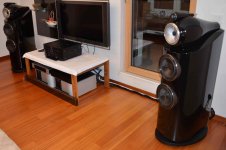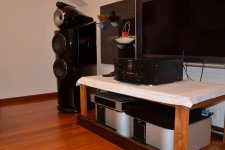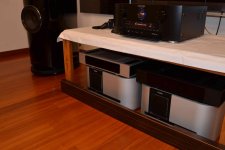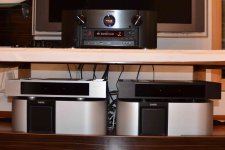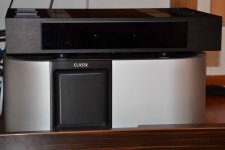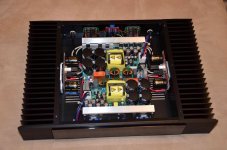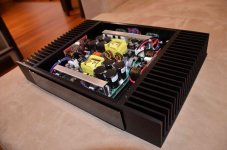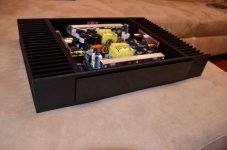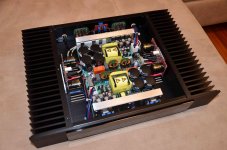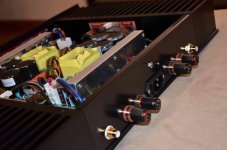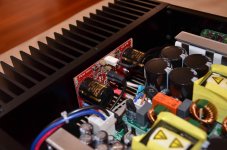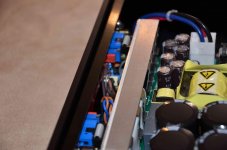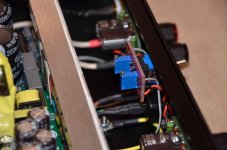Very simple explanation, SMPS having only 660 uF per rail, FO module having 2200 uF per rail and there's 0,3 A quiescent current plus error current in a case of failure. Sum of both currents discharge 2860 uF rapidly so the energy delivered to speaker is tiny, most energy in a case of failure is consumed within module, output just dies. Once testing FO with battery powered preamp, I got +12 V DC on preamp's output (- battery was disconnected accidentally), after First One switched on, both SMPSs just went to shutdown, speakers didn't even have time to produce plop sound, the only indication was dark LEDs on the front plate.Thank you, dear LC, for your detailed explanation. I still wonder what the path for discharge of module's main caps is...
Listening sessions began...this amp is like putting immense super-headphones! That detailed and textured it is! After listening Bartok's Violin concerto I can say: strings attacks and pizzicatti are lovely; drums attacks are fast and punchy ( You feel the leather being kicked); soundstage is huge, beyond speakers; bass is very deep but better, the images produced by the bass emitting instruments are proportionate to them; voices are fleshy...
VSSA is good but F.O. is on another league.
Thank you again, Master
So is that good, nice.
I have another question:
Can I use the technique of adding 10Ohm resistors to the power rails to calibrate iddle current instead?
I don't dare to use my lousy meter, which lack clamps, in series, for fear of disconnecting the power for one rail...
Best wishes,
M.
Yes of course, use +rail serial 10 Ohm/10 W wirewound ceramic resistor, voltage drop should be 2,8 V (i.e. 280 mA).
Regards, L.C.

Very simple explanation, SMPS having only 660 uF per rail, FO module having 2200 uF per rail and there's 0,3 A quiescent current plus error current in a case of failure. Sum of both currents discharge 2860 uF rapidly so the energy delivered to speaker is tiny, most energy in a case of failure is consumed within module, output just dies. Once testing FO with battery powered preamp, I got +12 V DC on preamp's output (- battery was disconnected accidentally), after First One switched on, both SMPSs just went to shutdown, speakers didn't even have time to produce plop sound, the only indication was dark LEDs on the front plate.
Thank you for the detailed explanation. Now I get it.
About calibration: so there is no need to add a similar 10Ohm resistor to the (-) rail while doing it, right?
I am enjoying how F.O. resolves massive orchestral scores.
Still braking-in...
Best wishes,
M.
About calibration: so there is no need to add a similar 10Ohm resistor to the (-) rail while doing it, right?
No, just 10 Ohm in series to positive rail (no 10 Ohm resistor in negative rail) for the measuring period only, then remove it.
I am enjoying how F.O. resolves massive orchestral scores.
Amazing isn't it.
No dynamic compression, no sign of distortions, that is the First One's signature.
No, just 10 Ohm in series to positive rail (no 10 Ohm resistor in negative rail) for the measuring period only, then remove it.
Thanks!
No dynamic compression, no sign of distortions, that is the First One's signature.
...and the timbres and textures of each instrumental section are beautifully preserved and distinguishable, while keeping the wholeness of the music.
I think soon will be time for Bach's Passions...
Hi,
LC, may I ask if the FO uses a kind of 10 ohms resistor between the In- and the GND or if this is a straight path ?
Reason is that I m designing a volume control module which would be able to drive 2 or 4 modules (biamp or bridge) and I try to sort out a schematic compatible with single or dual smps while keeping a single ground reference at the rca (or xlr) inputs. For the time being I see only a solution around differential amplifier like THAT1280 or so to interface with each FO with their REF pin going to each FO In-, and then a 10oh res would reduce cmmr perf of the That.
thx
LC, may I ask if the FO uses a kind of 10 ohms resistor between the In- and the GND or if this is a straight path ?
Reason is that I m designing a volume control module which would be able to drive 2 or 4 modules (biamp or bridge) and I try to sort out a schematic compatible with single or dual smps while keeping a single ground reference at the rca (or xlr) inputs. For the time being I see only a solution around differential amplifier like THAT1280 or so to interface with each FO with their REF pin going to each FO In-, and then a 10oh res would reduce cmmr perf of the That.
thx
Last edited:
Hi MaxHi,
LC, may I ask if the FO uses a kind of 10 ohms resistor between the In- and the GND or if this is a straight path ?
Input GND pin on the module has zero ohm connection to central GND pin on the module where all three GND potentials meet (GND from input, GND from PSU and return GND for speaker).
There's no other GND connection to chassis or to common input GND, on contrary there's complete isolation to chassis and between the channels (block schematic in user manual attached).
All that means you can freely connect all modules to one GND reference point according to your multichannel block schematic.
Regards, L.C.
Attachments
So , I have been listening to the New FO for a while now and I have to say that for me it`s definitiv a Keeper .It is good with all Kinds of Musik and the Bass that was missing on 1.2 is very good now. The Sound is clean,detailed and dynamic .Last Night I took it to a Friend who wanted to check it out and he was really pleased. We listend to Kodo, Misa Criola, Zaz,Billy Cobham,Chris Rea and some more , it was a long Night. He got some old B+W802 Speakers which can handle some Power and FO was enough for them.
One Problem for me is, when things get better ,I start listening louder all of the Time ,so think twice if Your Wife can handle that.
Happy listening DT
One Problem for me is, when things get better ,I start listening louder all of the Time ,so think twice if Your Wife can handle that.
Happy listening DT
One Problem for me is, when things get better ,I start listening louder all of the Time ,so think twice if Your Wife can handle that.
Happy listening DT
Aha! That's why she left....haha.
R.
Hehe B&W802 D3 specials this weekend.He got some old B+W802 Speakers which can handle some Power and FO was enough for them.
Just came home from a wonderful First One bi-amping test with B&W802 D3 and I can only just say:"No limits!"
This speaker is so gooood, I'm speechless, I thought I knew some music to the bones, of course I was totally wrong ...

Pics following tomorrow ..

Tacco



As promised few pics from yesterday B&W802 D3 presentation. Classe CA-M300 acts like a good 40 kg stands (each). 
Attachments
Black Mamba completed!
Black Mamba inside just before ... already miss her.
Black Mamba inside just before ... already miss her.

Attachments
Black Mamba inside just before ... already miss her.
A beauty.
What brand and metal type are the speaker binding posts?
I performed calibration of my unit successfully. One side was 330mA the other 310mA, so not too deviated.
Looking forward for kit form pricing
Cheers,
M.
PS: What was the B&W owner's opinion?
I'll wait for some, let's say ten or more, SQ reports, then your wish will be fulfilled.I miss promised audio measurements...
It really is, thanks.A beauty.
What brand and metal type are the speaker binding posts?
I performed calibration of my unit successfully. One side was 330mA the other 310mA, so not too deviated.
Looking forward for kit form pricing
Cheers,
M.
PS: What was the B&W owner's opinion?
They're derivative of Furutech, link to the original binding posts.
Bias could easily be set the same for both channels. 280 mA is recommended at 60-63 V, if your SMPS is less than 50 V, 330 mA is OK.
We'll do calculation this week as having an appointment with my chassis provider.
Regards, L.C.

P.S. As to the latest info Classé monos already packed.
- Home
- Vendor's Bazaar
- First One - mosFET amplifier module
